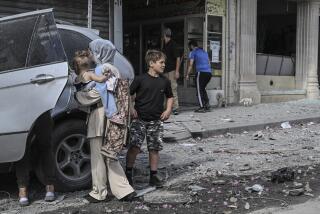Too Little Shock, Not Enough Awe
- Share via
NEW YORK — As President Bush flew off to Florida on Wednesday to rally the troops, White House spokesman Ari Fleischer told reporters the president intended to say: “Our progress is ahead of schedule, yet this war is far from over.” By the time the president addressed his Tampa audience, the phrase “ahead of schedule” had been dropped from the speech.
But is the war in Iraq behind schedule? And is it going according to plan? It all depends on which schedule and which plan you mean.
From the start, the Pentagon favored an unconventional war plan. This plan assumed that a precision air campaign of “shock and awe,” aided by special operations and psychological warfare, would shake the regime out of power, provoking a near-bloodless unraveling of Baath rule and thus averting the need for warfare in Baghdad and for massive destruction in the nation’s heartland.
Plan A has not achieved what military planners had hoped. Partly, that is a testament to Saddam Hussein’s resilience. He has spent the last 23 years outlasting wars, coups, purges and assassination attempts; it should not have been surprising he would put up a good fight.
But Plan A’s failure is also one of American overconfidence. With all the talk of shock and awe, and the widely held American belief that Hussein was an unpopular weakling, the administration became enamored of a strategy likely to fail. In the weeks leading up to the campaign, Air Force planners say, hundreds of targets were rejected for fear of civilian casualties. Indeed, at the time this article went to press, after 10 days of war, water and electricity were still flowing in Baghdad. But this was not just an act of mercy: At the highest levels of the administration, officials believed the regime was near collapse and that a truly punishing bombing campaign would be overkill.
If all goes well from here on, these punches pulled to lessen Iraqi civilian hardships will seem brilliant. But the surgical bombing didn’t do much to increase the odds of Plan A’s success: In the end, it’s hard to generate much awe if you’re not willing to supply meaningful shock to your enemy.
So now we move on to Plan B, a much more conventional war, and one that’s proceeding just about as well as could be expected. In less than two weeks, more than 90,000 coalition troops have moved into Iraqi territory. Three fronts, in the north, south and west, have been opened, and in less than a week the forward-most troops pulled up outside of Baghdad.
Planners admit they were unprepared for the ferocity of Fedayeen fighters in the south. But they should not be surprised at being surprised. An Iraqi military that was soundly defeated by air power and conventional battle in the 1991 Gulf War was bound to make adjustments to how it fights the U.S., and it has. The Iraqis have turned to guerrilla warfare, clothing irregular fighters in civilian garb and hugging urban enclaves as if they were jungles. They are breaking the “rules” of organized warfare.
Still, Baghdad is surrounded, cut off from the outside world. In the first week of intense warfare, some 7,000 bombs and missiles were dropped by the coalition. More weapons have landed in and around Baghdad than in the entire 43-day Gulf War. Eighty percent of all weapons expended have been precision-guided, and most have hit their targets.
So why are many Americans becoming convinced that the war is bogging down? In part it’s because American war planners have never clearly explained their strategy to the American public. Of course no one would expect them to discuss the kind of strategic details that would aid Iraq. But they have never, even in broad strokes, provided a timetable or discussed contingencies. “We have to preserve the security of the operation,” Brig. Gen. Vincent Brooks said Wednesday in Qatar. “That’s our first priority, and we are going to do that.” Even, it seems, at the cost of some public support for the war.
Nonetheless, it is possible to piece together a pretty good picture: Special operations and simultaneous air and ground operations were intended to cut Baghdad off. The rapid ground move into Iraq was to demonstrate to the Iraqi people and their army that this time the U.S. was serious, that this would not be a war fought only from the air. U.S. intelligence believed that Iraq had drawn a red line around the approaches to the capital, a line that once crossed could trigger the launch of chemical or biological weapons. So the plan was never to rush into Baghdad, but rather to pull up at a safe distance outside the city and weaken its defenses while air and special operations forces continued to attack military and security operations and moved to disable any artillery batteries and missiles capable of delivering chemical weapons.
Given this plan, things are going about as well as can be expected. Key to the American strategy is eliminating Iraq’s ability to deliver weapons of mass destruction -- and, through psychological warfare, dissuading Iraqi officers from following orders to use them. Once Iraqi regular forces are depleted to Gen. Tommy Franks’ satisfaction, and once the means to deliver weapons of mass destruction are eliminated, ground forces are scheduled to advance.
That doesn’t mean the rest will be easy. The U.S. military is superb at “regular” warfare. It can take out any target within its sights and is superior on the traditional battlefield to any military on the planet. What it doesn’t do well -- has never done well -- is irregular warfare against a determined opponent embedded within the civilian population. The more the Iraqi regime uses its militias and cities and civilian population to do battle, the more the U.S. advantage diminishes. That probably means fighting in Baghdad, particularly if the regime doesn’t magically crumble. The administration says it is willing to wait weeks or even months to let other strategies play out, but Hussein’s willingness to inflict hardship on his citizens may force the U.S. hand.
Once the war is over, military analysts and pundits will have their day deconstructing the war’s battles and analyzing U.S. strategy. A key question may well be this one: Did American overconfidence in holding back on shock and awe result in a more deadly and destructive end game? Eventually, we will know the answer.
More to Read
Get the L.A. Times Politics newsletter
Deeply reported insights into legislation, politics and policy from Sacramento, Washington and beyond. In your inbox twice per week.
You may occasionally receive promotional content from the Los Angeles Times.









